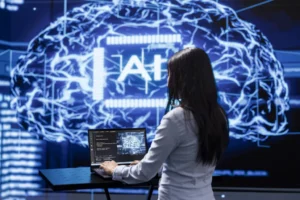Generative Artificial Intelligence is no longer a trend. It is a transformative reality, reshaping how we work, create, and engage with the world.
From social media and corporate systems to how we build software, this technology has proven to be a powerful ally in content creation, process automation, and innovation across industries.
In this article, we will demystify Generative AI, exploring its key models, applications, and how it changes the way we interact with the world.
Get ready for a practical and insightful guide to using this technology effectively and creatively.
1. What is Generative Artificial Intelligence (Gen AI)?
Generative Artificial Intelligence, or Gen AI, is a technology that’s revolutionizing how we create content and approach work. Imagine a system capable of producing new ideas and outputs like text, image, music, or video. Well, that’s exactly what Gen AI does! It learns from existing data and generates original results, offering creative solutions to complex problems.
Its impact spans sectors such as healthcare, marketing, and software development, creating tangible value and ROI.
On top of that, Generative Artificial Intelligence also holds significant economic potential, allowing companies to explore new forms of engagement and innovation. According to consulting firm Bain & Company, the AI products and services market could reach $780 billion to $990 billion by 2027.
2. What is the Difference Between Traditional AI and Generative AI?
Artificial Intelligence (AI) broadly refers to systems that perform tasks requiring human-like intelligence, such as recognizing patterns, making decisions, or understanding language. Within this field, we can distinguish between two types of AI: traditional and generative.
Traditional AI focuses on interpreting and acting on existing data. Using techniques such as Machine Learning and Deep Learning, it identifies patterns, classifies information, and makes predictions.
Recommendation systems like Netflix or Spotify, for example, use traditional AI to analyze your behavior and suggest relevant content. This form of AI emulates human cognitive functions by identifying patterns and making predictions. However, traditional AI doesn’t create anything new; its insights are limited to existing inputs.
Generative AI, on the other hand, does create. It goes beyond analysis and generates new, original content. Tools like ChatGPT are examples of this technology, capable of transforming simple prompts into entirely new outputs.
3. How does Generative AI Work?
Understanding how Gen AI works helps to clarify its capabilities. It typically involves four components:
Foundation Models
The first is the development of foundation models. These are trained on massive volumes of unlabeled data such as text, images, video, and audio to learn complex patterns and relationships. The result is a model that can generalize across tasks.
Fine-Tuning
Once the foundation is built, the model is refined using labeled data representing tailored to specific cases. For instance, if used in customer service, the model might be fine-tuned on real conversation logs to improve accuracy and context awareness.
Interaction Through Prompts
Users engage with Gen AI through prompts, which are questions or instructions that guide the model’s response. The quality of these prompts directly impacts the relevance of the output. This is why Prompt Engineering is becoming a key skill.
Continuous Improvement
Finally, to keep outputs relevant and accurate, Gen AI models are regularly evaluated, updated, and improved. Feedback from users also helps refine the models over time.
4. What are the benefits of Generative AI?
Increased Productivity
Gen AI is driving change at every level. Among its top benefits is increased productivity. Gen AI automates time-consuming everyday tasks like writing, editing, summarizing, or coding, saving hours and boosting team efficiency.
Personalization
It also enables highly personalized content and user experiences, improving customer engagement and satisfaction.
Solving Complex Problems
Generative Artificial Intelligence can be a valuable ally in solving complex problems. By analyzing vast amounts of information, it can generate meaningful insights and propose innovative solutions.
This is particularly impactful in fields such as scientific research and medical diagnostics. For instance, Gen AI can examine medical imaging like CT scans and MRIs to detect anomalies with a level of accuracy that may surpass human capabilities. In research environments, it can explore and interpret data from diverse sources, helping researchers identify patterns, generate hypotheses, and accelerate discovery.
Reduction of Operational Costs
Gen AI-powered automation can significantly reduce costs in areas such as customer service and technical support. Tools like chatbots and virtual assistants can be deployed to answer customers and even solve simple demands. They can also be set up to send users personalized messages and offers.
Optimization of Business Processes
Additionally, Generative AI helps optimize business processes by applying machine learning across different units or departments. As an illustration, it can generate synthetic data to improve model training, enhancing decision-making and operational efficiency.
Reduced Time-to-Market
Finally, it can accelerate time-to-market by, among other things, enabling faster prototyping and testing at a lower cost. This allows businesses to launch new products and services more quickly while consuming fewer resources.
5. What are the Risks of Generative AI?
Generative AI fuels innovation, but it also presents important risks that must be addressed with care and responsibility to ensure the safe and ethical use of the technology.
Privacy and Security
Because generative models require vast datasets to be trained and refined, they often handle sensitive or proprietary information. This opens up the possibility of unintentional data exposure or misuse. For example, an AI trained on confidential company documents or user interactions might accidentally reveal private data in its output.
There is also the growing risk of malicious use, such as the creation of deepfakes or realistic fake content designed to mislead, manipulate, or defraud individuals and organizations. To mitigate these risks, companies must adopt strict security protocols, invest in robust data anonymization strategies, and ensure proper access controls are in place throughout the AI lifecycle.
Regulatory Compliance
The rapid pace of Gen AI adoption has outstripped the development of comprehensive legal and ethical frameworks. As a result, many companies are left navigating a patchwork of local, national, and international regulations. Compliance with existing data protection laws is crucial; however, new AI-specific policies and guidelines are emerging globally, and organizations must stay up to date to avoid legal exposure.
Intellectual Property
Intellectual property is also at stake. Because Gen AI can generate new content, that raises complex copyright and intellectual property issues. Organizations must create clear policies around the use and protection of AI-generated content and ensure respect for third-party rights.
Bias and Discrimination
AI models can inadvertently perpetuate biases contained in the data on which they were trained. A well-known example occurred in 2018, when a hiring tool used by Amazon showed discriminatory behavior against female candidates, a result of being trained on historically male-dominated data.
To prevent similar issues, organizations must implement controls to detect and mitigate biases, making sure their AI outputs are fair and ethical.
6. What are the Limitations of Generative Artificial Intelligence?
Although Generative AI offers remarkable capabilities, it also has inherent limitations that must be understood to ensure its responsible and effective use.
Below, we look at some of its main limitations:
Accuracy and Reliability
Even the most advanced Gen AI models are not immune to error. These systems generate outputs based on patterns found in the data they were trained on, which means they may reproduce or even amplify inaccuracies, inconsistencies, or biases present in that data.
In certain cases, AI may “hallucinate,” producing outputs that are entirely fabricated but presented with confidence and fluency. This risk becomes especially critical in sensitive domains such as healthcare, finance, or legal services, where misinformation can have serious consequences.
To mitigate this, human oversight is essential. Organizations should implement review protocols to validate outputs before they are used in production environments, ensuring that the AI serves as a support tool rather than a final authority.
Creativity Constraints
While Gen AI can simulate creativity by producing content that appears original, its “imagination” is bound by the data it has been trained on. True originality is still a human domain, especially when it involves emotional understanding.
One way to overcome this limitation is to adopt a co-creation model, in which AI augments human creativity rather than replacing it. By leveraging Gen AI as a collaborative partner, creators can iterate more quickly, test ideas efficiently, and ultimately push the boundaries of what’s possible — without losing the human touch.
7. What are the Generative Artificial Intelligence Models?
Different generative AI models are expanding the limits of what can be achieved, from generating text to creating images and sounds. Below are the main model types, how they work, and where they are most effective.
Diffusion Models
How they work: These models begin by adding noise to the training data until it becomes unrecognizable. Then, the algorithm is trained to reverse this process and recover a coherent and meaningful output.
Applications: Primarily used for image and video generation, diffusion models allow precise control over the creative process and are known for producing high-resolution results.
Generative Adversarial Networks (GANs)
How they work: GANs consist of two neural networks operating in a competitive setup. The generator creates synthetic data, while the discriminator evaluates whether the data is real or fake. This back-and-forth improves the model’s ability to generate increasingly convincing outputs.
Applications: Widely applied in image generation, style transfer, and data augmentation. GANs are often used in creative industries and synthetic media.
Variational Autoencoders (VAEs)
How they work: VAEs rely on two neural components, a neural encoder and a decoder, which work together to learn a compact representation of the data. From this compressed form, the decoder can reconstruct variations that resemble the original inputs.
Applications: Particularly effective for generating images and videos that preserve the essence of the training data. Also valuable for data compression and representation learning.
Transformers
How they work: Transformers use a self-attention mechanism to understand the context and relationships between elements in a sequence, such as words in a sentence. This architecture allows them to generate coherent and contextually appropriate outputs.
Applications: Core to Natural Language Processing (NLP), transformers power models like GPT (Generative Pre-trained Transformer), which are widely used in chatbots, translation tools, summarization systems, and virtual assistants.
Large Language Models (LLMs)
How they work: LLMs are large-scale transformer-based models trained on extensive corpora of text data. They predict and generate natural language based on context and user input.
Applications: Found in many AI-powered tools, including content generators, conversational agents like ChatGPT, and customer support solutions that rely on natural language understanding.
8. What is the Best Generative AI Tool?
As with many challenges in technology, the answer to this question is “it depends.” To understand which Artificial Intelligence application is ideal for your case, ask yourself a few questions:
- What do I want to achieve?
- In what environment will this be used?
- What results am I expecting?
- Do I need to consider any significant time or budget constraint?
9. How to Adopt Generative AI?
Adopting generative AI is a strategic step that can transform business processes and outcomes. Below is a practical guide for implementing this technology effectively and securely.
Clear Communication
When introducing generative AI, it is essential to maintain open and honest communication with all stakeholders. Doing so not only reduces uncertainties but also ensures everyone is aligned with the organization’s goals.
Establish dedicated channels to quickly answer questions and encourage cross-team collaboration. Treat AI adoption as a collective initiative to maximize its positive impact.
Balancing AI and Human Collaboration
Even the most advanced AI requires human input. People play a critical role in training models, providing contextual interpretation, and guiding ethical and responsible use.
Professionals must be equipped to supervise, adjust and validate AI behavior so that the technology complements rather than replaces human expertise.
Start with Internal Applications
Deploying generative AI in internal workflows is a strategic first move. It creates a controlled environment for testing, refining, and learning.
This approach enables teams to develop confidence with the technology before introducing it to external-facing operations. When the time comes, thoroughly customized and tested internal models help deliver a better user experience.
Double Attention to Security
Information security must be prioritized when adopting generative AI.
Protect Your Data
Implement strong protections to prevent unauthorized access to sensitive information. This includes applying data masking and removing personally identifiable information (PII) before using data in AI model training.
Involve the Security Team from the Beginning
Include security professionals early in the process. Doing so allows your team to address risks from the design stage through to deployment.
Prepare for Cyber Threats
New threats are emerging as generative AI advances. These include deepfakes and other tools used in social engineering attacks. Mitigate these risks by developing robust controls and updating your security policies to address AI-related vulnerabilities.
Work with Reliable Suppliers
If you use third-party AI tools or services, confirm that they do not use your data for purposes outside your organization. Build clear contracts and maintain transparent communication with suppliers to protect your data and minimize misuse.
Test a Lot
Develop thorough testing processes to assess the quality and reliability of generative AI outputs. combine automated and manual tests to simulate a wide range of scenarios.
Beta testing groups can provide valuable insights and surface edge cases that help fine-tune the model before broader deployment. Testing is key to ensuring that your implementation supports strategic goals.
Be Transparent
Transparency builds trust and supports ethical AI adoption. After all, to ensure efficient adoption, there must be trust in the technology and its intentions.
This level of clarity is not only the best practice but also aligns with global guidelines such as the OECD recommendations on AI, which are included in Brazil’s Artificial Intelligence Strategy (EBIA).
Continuous Monitoring
Once generative AI is in place, continuous monitoring is essential. Regular oversight ensures the system performs as expected, detects anomalies early, and responds to any new risks or failures.
Ongoing evaluation also enables teams to make improvements that keep the solution aligned with evolving business needs.
Recommended reading: Challenges in AI adoption: How to transform obstacles into competitive advantages
10. What is the Future of Generative AI?
To understand the future of generative AI, it helps to look at Gartner’s predictions:
- By 2026, 75% of companies will use Generative Artificial Intelligence to create synthetic customer data. This represents a significant leap from less than 5% in 2023. Synthetic data refers to information generated through algorithms, simulations, or computational models rather than collected from real-world human activity.
- By 2027, more than half of the generative AI models adopted by companies will be designed for specific industries or business functions. In 2023, this figure was approximately 1%.
- By 2028, 30% of GenAI implementations will be optimized using energy-efficient computing methods. This shift will be driven by sustainability commitments and the need to reduce the environmental impact of AI operations.
Conclusion
We are undoubtedly just beginning to explore the full potential of Generative Artificial Intelligence. From automating tasks to redefining entire industries, this technology continues to reshape what is possible in the digital world.
However, as with any disruptive innovation, there are challenges to overcome. Responsible governance, robust security practices, and transparent implementation will be key to building trust and ensuring long-term success.
Now, we want to hear from you! What other questions do you have about Generative Artificial Intelligence? Leave a comment and let’s continue the conversation!
References
- What Is Generative AI? | AWS
- What is generative AI? Examples and Use Cases| Google Cloud
- Managing the risks of generative AI – PwC
- When Not to Use Generative AI | Gartner
- Generative AI: What Is It, Tools, Models, Applications and Use Cases | Gartner
- Gartner Generative AI Predictions for 2024-2028 | Gartner
- Generative AI: What CIOs and CTOs need to know | StackSpot AI
- Gen AI in legacy modernization: 6 practices for adopting | StackSpot AI
- O que é ‘alucinação’ de inteligência artificial – BBC News Brasil
- Tipos de IA Generativa: explorando as inovações e aplicações – Meta
- Dados sintéticos vs dados naturais: o limite da inteligência artificial no treinamento de modelos – Coluna Marcos Bonas, TI INSIDE Online
- Qual o impacto da IA Generativa? – Portal Telemedicina
- IA Generativa: o que é, como funciona e aplicações | Distrito
- IA Tradicional e IA Generativa: qual a diferença e qual a melhor? | Zendesk
- IA Generativa: o que é, vantagens e exemplos – Sankhya
- Conheça os 4 maiores riscos da IA generativa e saiba como mitigá-los – InfoMoney
- Guia Completo Sobre Inteligência Artificial Generativa – Data Science Academy

 Skip to content
Skip to content


